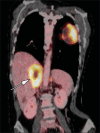Imaging of the adrenal gland lesions
- PMID: 25741090
- PMCID: PMC4337123
- DOI: 10.1590/0100-3984.2013.1762
Imaging of the adrenal gland lesions
Abstract
With the steep increase in the use of cross-sectional imaging in recent years, the incidentally detected adrenal lesion, or "incidentaloma", has become an increasingly common diagnostic problem for the radiologist, and a need for an approach to classifying these lesions as benign, malignant or indeterminate with imaging has spurred an explosion of research. While most incidentalomas represent benign disease, typically an adenoma, the possibility of malignant involvement of the adrenal gland necessitates a reliance on imaging to inform management decisions. In this article, we review the literature on adrenal gland imaging, with particular emphasis on computed tomography, magnetic resonance imaging, and photon-emission tomography, and discuss how these findings relate to clinical practice. Emerging technologies, such as contrast-enhanced ultrasonography, dual-energy computed tomography, and magnetic resonance spectroscopic imaging will also be briefly addressed.
O crescente uso da tomografia computadorizada e da ressonância magnética levou a um aumento na identificação de nódulos adrenais incidentais, também chamados de incidentalomas, gerando um impasse diagnóstico para o radiologista, bem como um número significativo de pesquisas a fim de caracterizar essas lesões como benignas ou malignas. Apesar de a maioria dos incidentalomas representar um processo benigno, geralmente um adenoma, a possibilidade de a lesão ser maligna requer suficiente acurácia dos métodos de imagem para que esses possam auxiliar no manejo dos pacientes. Neste artigo nós apresentamos uma revisão da literatura dedicada à investigação radiológica das lesões adrenais, com ênfase na tomografia computadorizada, ressonância magnética e tomografia por emissão de prótons, e discutimos como os achados de imagem relacionam-se com a prática clínica. Tecnologias recentes, como a ultrassonografia com uso de contraste, a tomografia computadorizada com dupla fonte de energia e a espectroscopia de prótons por ressonância magnética são brevemente discutidas.
Keywords: Adenoma; Adrenal gland; Cancer; Diagnosis; Radiology.
Figures














Similar articles
-
The indeterminate adrenal lesion.Cancer Imaging. 2010 Mar 18;10(1):102-13. doi: 10.1102/1470-7330.2010.0012. Cancer Imaging. 2010. PMID: 20299300 Free PMC article. Review.
-
Contemporary imaging of incidentally discovered adrenal masses.Biomed Pharmacother. 2017 Mar;87:256-262. doi: 10.1016/j.biopha.2016.12.090. Epub 2017 Jan 4. Biomed Pharmacother. 2017. PMID: 28063406 Review.
-
Radiology of the adrenal.Endocrinol Metab Clin North Am. 2000 Mar;29(1):27-42, viii. doi: 10.1016/s0889-8529(05)70114-6. Endocrinol Metab Clin North Am. 2000. PMID: 10732262 Review.
-
Radiologic evaluation of incidentally discovered adrenal masses.Am Fam Physician. 2010 Jun 1;81(11):1361-6. Am Fam Physician. 2010. PMID: 20521756 Review.
-
Advances in our understanding of the prognosis of adrenal incidentaloma.Expert Rev Endocrinol Metab. 2016 Nov;11(6):529-541. doi: 10.1080/17446651.2016.1233055. Epub 2016 Sep 20. Expert Rev Endocrinol Metab. 2016. PMID: 30058921
Cited by
-
Magnetic resonance imaging of adrenal gland: state of the art.Gland Surg. 2019 Sep;8(Suppl 3):S223-S232. doi: 10.21037/gs.2019.06.02. Gland Surg. 2019. PMID: 31559189 Free PMC article. Review.
-
Bilateral adrenal haemorrhages: a crucial incidental finding.BJR Case Rep. 2016 Dec 8;3(2):20160107. doi: 10.1259/bjrcr.20160107. eCollection 2017. BJR Case Rep. 2016. PMID: 30363301 Free PMC article.
-
Apparent diffusion coefficient of normal adrenal glands.Radiol Bras. 2016 Nov-Dec;49(6):363-368. doi: 10.1590/0100-3984.2015.0045. Radiol Bras. 2016. PMID: 28057963 Free PMC article.
-
Retroperitoneal hematoma by different causes: Presentation of two emergency cases at computed tomography.Radiol Case Rep. 2021 Jul 9;16(9):2551-2556. doi: 10.1016/j.radcr.2021.05.053. eCollection 2021 Sep. Radiol Case Rep. 2021. PMID: 34306286 Free PMC article.
-
Synchronous liver metastasis at initial diagnosis of adrenal pheochromocytoma by CT: A case report.Oncol Lett. 2024 May 17;28(1):329. doi: 10.3892/ol.2024.14462. eCollection 2024 Jul. Oncol Lett. 2024. PMID: 38807675 Free PMC article.
References
-
- Zeiger MA, Siegelman SS, Hamrahian AH. Medical and surgical evaluation and treatment of adrenal incidentalomas. J Clin Endocrinol Metab. 2011;96:2004–2015. - PubMed
-
- Young WF., Jr Clinical practice. The incidentally discovered adrenal mass. N Engl J Med. 2007;356:601–610. - PubMed
-
- Song JH, Chaudhry FS, Mayo-Smith WW. The incidental adrenal mass on CT: prevalence of adrenal disease in 1,049 consecutive adrenal masses in patients with no known malignancy. AJR Am J Roentgenol. 2008;190:1163–1168. - PubMed
-
- Lenert JT, Barnett CC, Jr, Kudelka AP, et al. Evaluation and surgical resection of adrenal masses in patients with a history of extraadrenal malignancy. Surgery. 2001;130:1060–1067. - PubMed
-
- Lam KY, Lo CY. Metastatic tumours of the adrenal glands: a 30-year experience in a teaching hospital. Clin Endocrinol. 2002;56:95–101. - PubMed
Publication types
LinkOut - more resources
Full Text Sources
Other Literature Sources
